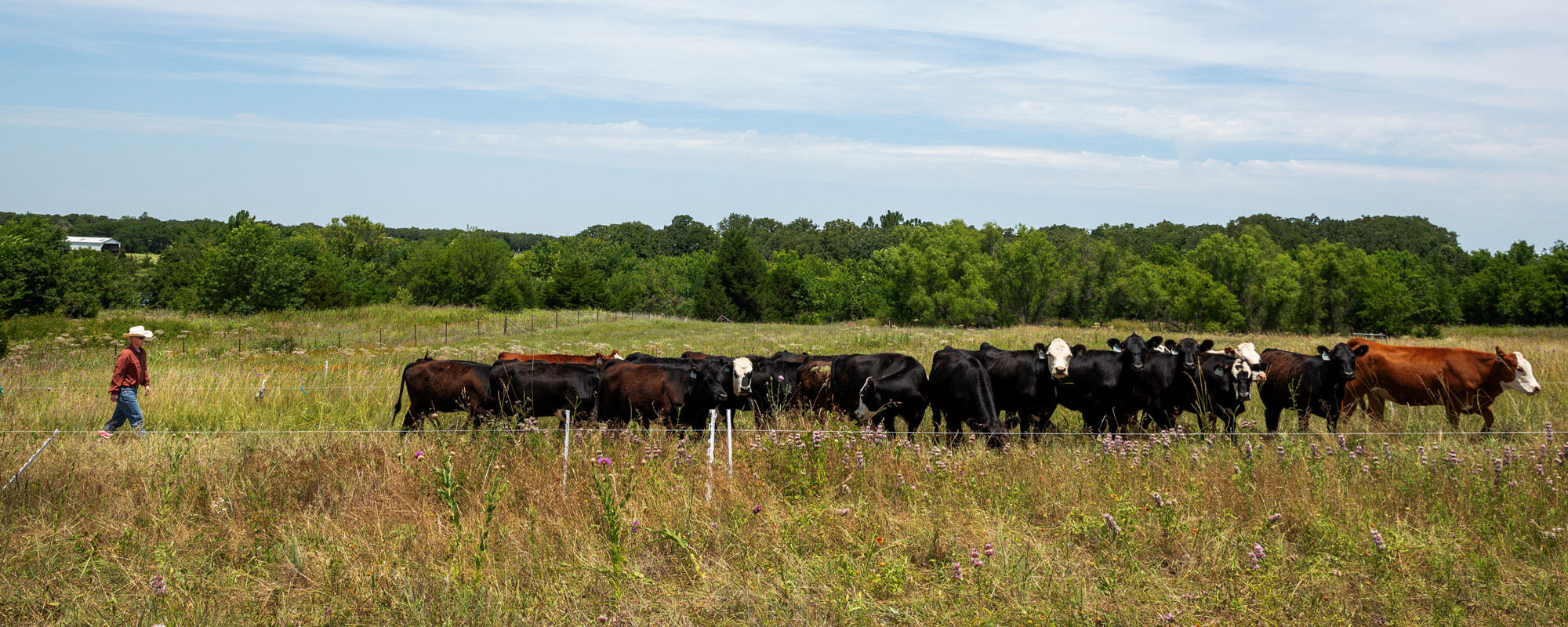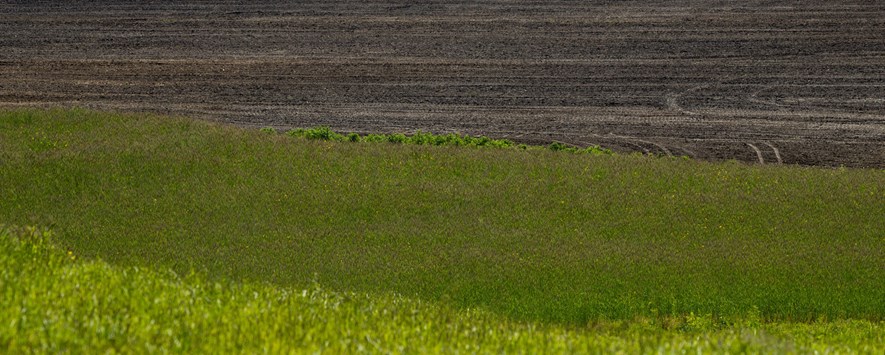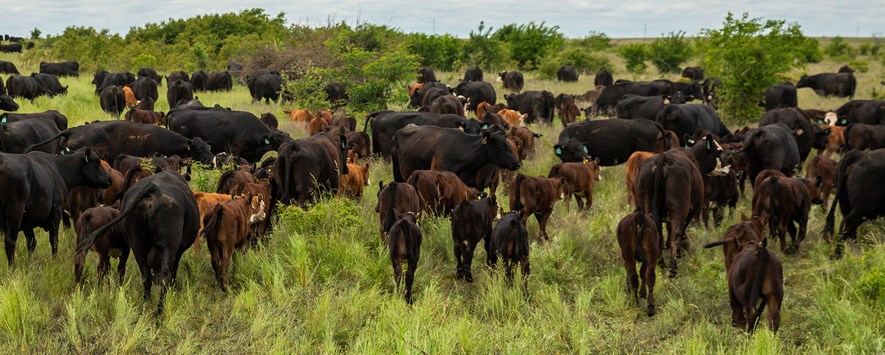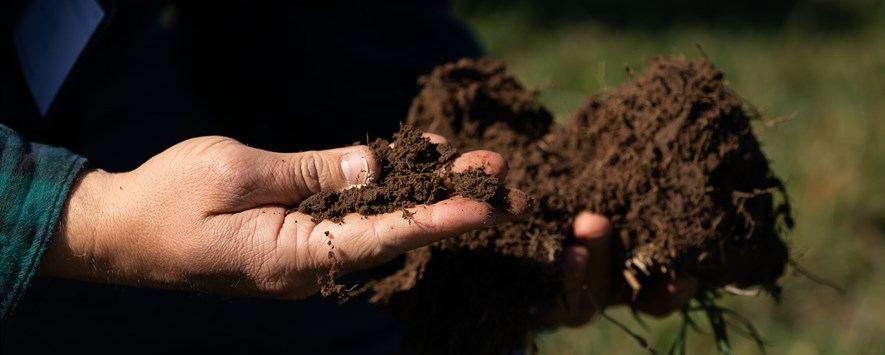While repeated, unchecked soil disruption goes against the third soil health principle to “minimize soil disturbance,” disrupting the soil in strategic and natural ways can positively benefit both a ranch’s productivity and the environment.
Noble Research Institute General Ranch Manager Joe Pokay has had a front-row seat to watch this balance play out on 14,000 acres of land across seven Noble Ranches stocked with cattle, sheep and goats.
The first step a ranch really needs to do is take a look at their goals. What are they really after? How much risk are they comfortable with? How much outside of their comfort zone can they go into?” Joe Pokay
“We're doing different types of disturbance to the soil at different frequencies,” he says. For example, sometimes it makes sense to trample standing mature forage with hoof action. “That is encouraging the soil microbial growth by feeding the soil microbes with forage we put back into the soil.”
Aldo Leopold once wrote, “The central thesis of game management is this: game can be restored by the creative use of the same tools which have heretofore destroyed it: axe, plow, cow, fire and gun. Management is their purposeful and continuing alignment.”
Pokay says the same principle applies to soil health. Over time, the health of rangeland soils across the country has been depleted by the repeated, manmade disruptions of plowing, overgrazing, allowing brush encroachment and more. But on the flipside, the intentional and judicious use of disruptions such as grazing livestock, mechanical means and fire can restore rangeland to its former glory.

Manage with stocking rate and adaptive grazing
On the ranches Pokay manages, he places heightened emphasis on stocking rate and adaptive grazing. This requires careful evaluation of the land and livestock on a frequent basis to determine the correct rate and necessary adjustments.
“If we picked a stock density in an acre-sized paddock and said, ‘We rotate cows every day in this size paddock at this stock density at this time of day,’ you've completely gone away from being adaptive in your grazing management, and you are being prescriptive,” he explains.
By alternating species of livestock and fluctuating stocking rates, then following grazing events with longer periods of rest for the forage, Pokay says he and his team are encouraging the microbiology of the soil to be more productive by challenging it to do more.
He first saw the value of this strategy managing yearling cattle several years ago. Adaptive grazing takes advantage of cattle as natural fertilizer spreaders by balancing their time on each part of the pasture, giving the soil an equal chance to replenish nutrients. And not only was the grazing distribution more even due to smaller pasture size, Pokay also was able to see the cattle more frequently to monitor their health and condition.
Grazing smaller paddocks at the right stocking rate can benefit livestock nutrition, too.
“If you turn a cow out in a thousand acres, she'd probably just walk around graze exactly what she wants to graze every day and lay in the shade the rest of the day,” Pokay says. “But if you ask her to work a little bit, she will reap the positive benefits of eating plants she normally wouldn't select for that have high nutritional value.”

Recognize when additional disruptions are needed
However, just like anything extreme, using too high a stocking rate for too long can have negative cascading effects on soil health. Pokay says many ranchers battle brush encroachment today due to overgrazing many years before. These invasive plants are using valuable nutrients in the soil that the more desirable plants need to thrive — eventually making it difficult for higher-quality plants to grow at all.
“We can’t graze down a 4-inch post oak,” he says. “At that point, we introduce mechanical brush removal to try to open up some more grazeable acres.”
By removing invasive species from an area, a rancher allows more opportunity for desirable plants to grow. This may mean another form of mechanical disruption should be implemented during such a transition — planting cover crops. Pokay says this keeps a living root in the ground and eventually leads to more resilient rangelands.
“That's an example of a positive compounding and cascading disruption, because we're introducing diversity into our pastures,” Pokay says. “That accomplishes several of the soil health principles. The more diversity, the more resilient the whole system is to extremes in weather.”
The last form of soil disruption Pokay subscribes to is fire. Prescribed fire clears dead vegetation while also putting nutrients back into the soil. After a prescribed fire, a pasture often comes back more productive than before.
“We have been managing against soil health for so long, and that's why all these woody species have taken over,” he says. “So, we have to do something to reset the system, and that's where fire can come in. We can use fire to clean up some dead woody species and open more grazeable acres to manage with our grazing animals.”

Choose the best-balanced approach for your ranch
While each strategy has value, not every ranch needs to use every method to ensure soil health.
Pokay stresses the importance of finding the appropriate balance of soil-disruption strategies for the situation. No two ranches are the same, and therefore, a hard-and-fast prescriptive approach won’t yield desired results.
“Our goal is to increase our soil health with grazing animals and remain profitable,” he explains. “How each ranch does that is going to be different, because each ranch is different.”
Pokay and his team implement an adaptive stewardship strategy. This means there is a plan in place to achieve the respective goals. However, it is not set in stone.
“If you do that, you're trying to apply linear thinking into a very complex system,” he describes. “Linear thinking and linear problems don't apply to nature and our ecosystem.”
Factors to consider when using an adaptive stewardship strategy are the current state of the land, the goals of the operation and the historical weather patterns. Some ranches will need a more aggressive approach to reach the desired outcome, while others may benefit from a “less is more” philosophy.
For example, using a chemical to treat brush encroachment has some negative effects. However, in some situations, it may increase the soil health long term because more grazing animals can access the land to put down more manure and cycle nutrients through the soil much faster. Likewise, opening the canopy to get more sunlight through to desirable plants will increase the energy flow to the soil.
“The follow-up strategy to a chemical or mechanical brush treatment is most times more important than the initial treatment,” Pokay stresses.
For example, he explained after mulching, they planned to use goats to clean up the regrowth. If they’d used chemicals, they might follow up with fire.
“If we didn't have a plan, we would be right back where we started in a few years,” he says.

Start with mindset and goal setting
This type of management takes a shift in mindset and careful planning.
“The first step a ranch really needs to do is take a look at their goals,” Pokay emphasizes. “What are they really after? How much risk are they comfortable with? How much outside of their comfort zone can they go into?”
Tough questions, but important to ask and answer, even if the answers include soil disruptions that seem like a step backward at first glance. The results will be worth it in terms of productivity and sustainability.
When it comes to setting goals for improving the grasslands on the Noble Ranches, “we really go back to our historical ecological context,” Pokay says. “The Cross Timbers region, where our ranches are, was a post oak savanna with grasses throughout. That’s our goal. We want to have the diversity of all the functional groups of grasses, forbs and trees.”




